Chaos Information Entropy

Introduction
There are a lot of publications on Habr in which the concept of entropy is considered, these are just some of them [1 ÷ 5]. The publications were positively perceived by the readers and aroused great interest. It is enough to give the definition of entropy given by the author of the publication [1]: “entropy is how much information you do not know about the system”. Publications about the phenomenon of chaos on Habr is also sufficient [6 ÷ 9]. However, the relationship of entropy and chaos in both groups of publications was not considered.
This results from the fact that various areas of knowledge allocate different types of a measure of chaos:
')
- informational;
- thermodynamic;
- differential;
- cultural.
It also describes the measures of chaos, taking into account their specificity, even in one of these areas is quite difficult.
Trying to simplify the problem to the utmost, I decided to consider the relationship between informational entropy and chaos on the example of the similarity of the transmission areas from order to chaos on diagrams in the form of point mappings and on graphs of the entropy coefficient for these areas.
What came out of this you will learn by looking under the cat.
Mechanisms of transition from order to chaos
An analysis of the mechanisms of transition from order to chaos in real systems and various models revealed the universality of relatively few transition scenarios to chaos. The transition to chaos can be represented in the form of a diagram of bifurcations (the term “bifurcation” is used to denote the qualitative rearrangements of the system with the emergence of a new mode of its behavior).
The entry of the system into an unpredictable mode is described by a cascade of bifurcations, one after the other. The cascade of bifurcations leads consistently to the appearance of a choice between two solutions, then four, and so on, the system begins to oscillate in a chaotic, turbulent mode of successive doubling of the number of possible values.
We will consider period-doubling bifurcations and the appearance of chaos in point mappings. The display is a function that shows the dependence of the subsequent values of the system parameters on the previous values:
xn+1=f(xn)= lambdaxn(1−xn)
Consider also the second frequently used function:
xn+1=f(xn)= lambda cdotxn cdot(1−x2n)
With the help of point mappings, objects are studied not with continuous but with discrete time . In the transition to the mapping, the dimension of the system under study may decrease.
When the external parameter \ lambda changes, point mappings exhibit a rather complex behavior, which becomes chaotic with sufficiently large \ lambda. Chaos is a very fast running away of trajectories in phase space.
Bifurcation is a qualitative restructuring of the motion picture. The values of the control parameter at which bifurcations occur are called critical or bifurcation values.
To construct the diagrams, we will use the following two listings:
№1. For function: xn+1=f(xn)= lambdaxn(1−xn)
Program listing
# -*- coding: utf8 -*- import matplotlib.pyplot as plt from numpy import * def f(a,x0): x1=(a-1)/a# def ff(x):# return a*x*(1-x) def fl(x): return x x=x0;y=0;Y=[];X=[] for i in arange(1,1000,1): X.append(x) Y.append(y) y=ff(x) X.append(x) Y.append(y) x=y plt.title(' \n\ $x_{n+1}=\lambda \cdot x_{n}\cdot (1-x_{n})$ $\lambda$ =%s x0=%s '%(a,x0)) plt.plot(X,Y,'r') x1=arange(0,1,0.001) y1=[ff(x) for x in x1] y2=[fl(x) for x in x1] plt.plot(x1,y1,'b') plt.plot(x1,y2,'g') plt.grid(True) plt.show() No. 2. For function xn+1=f(xn)= lambda cdotxn cdot(1−x2n)
Program listing
# -*- coding: utf8 -*- import matplotlib.pyplot as plt from numpy import * def f(a,x0): x1=((a-1)/a)**0.5 def ff(x):# return a*x*(1-x**2) def fl(x): return x x=x0;y=0;Y=[];X=[] for i in arange(1,1000,1): X.append(x) Y.append(y) y=ff(x) X.append(x) Y.append(y) x=y plt.title(' \n\ $x_{n+1}=\lambda \cdot x_{n}\cdot (1-x_{n}^{2})$ $\lambda$ =%s x0=%s '%(a,x0)) plt.plot(X,Y,'r') x1=arange(0,1,0.001) y1=[ff(x) for x in x1] y2=[fl(x) for x in x1] plt.plot(x1,y1,'b') plt.plot(x1,y2,'g') plt.grid(True) plt.show() To assess the impact of the nature of the logistics function on critical values lambda consider diagrams with a function xn+1=f(xn)= lambdaxn(1−xn) for this we will apply listing 1:
When 0 <\ lambda <1 for lambda=$0.9 and x0 = 0.47 we get the diagram:

In this case, the mapping has a single fixed point. x∗=0
which is sustainable.
With 1< lambda<3 for lambda=2,5 x0 = 0.7 we get the diagram:
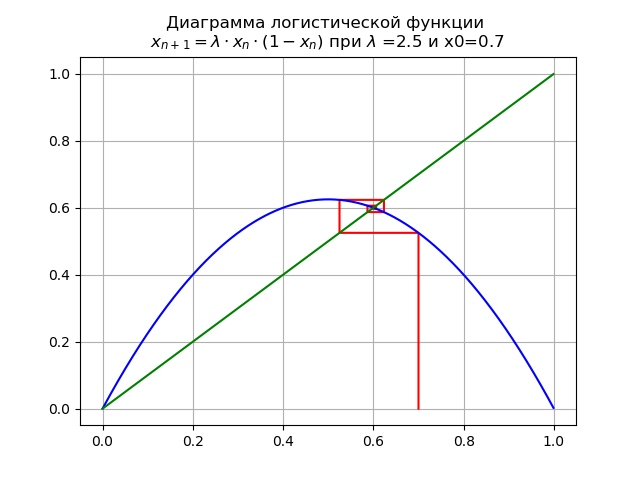
On the interval [0, 1] there appears one more fixed stable point. x∗1=1−1/ lambda
With 1< lambda<3 for lambda=2,5 and x0 = 0.01 we get the diagram:
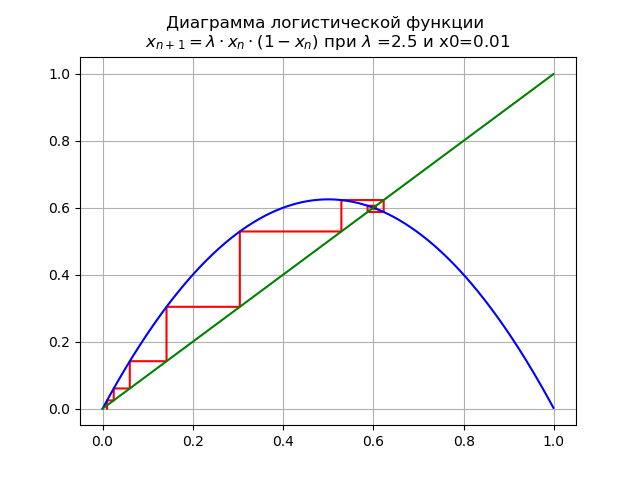
Fixed point x∗=0 , loses stability.
With 3< lambda<3.45 for lambda=$3.4 and x0 = 0.7 we get the diagram:
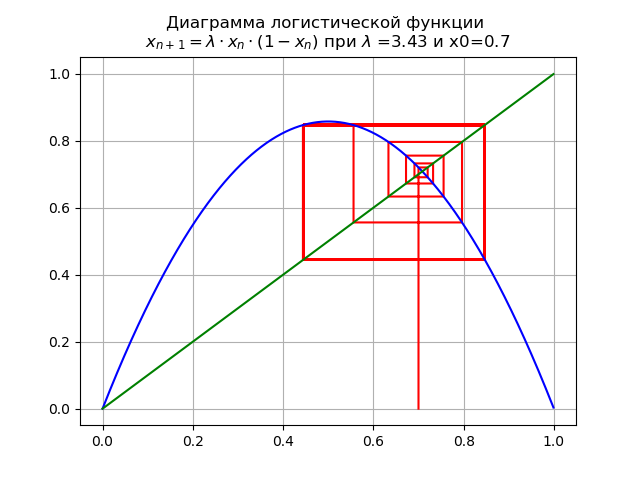
The mapping undergoes bifurcation: fixed point x∗1 becomes unstable, and a double cycle appears instead.
With 3.45< lambda<4.0 for lambda=$3.5
and x0 = 0,2 we get the diagram:
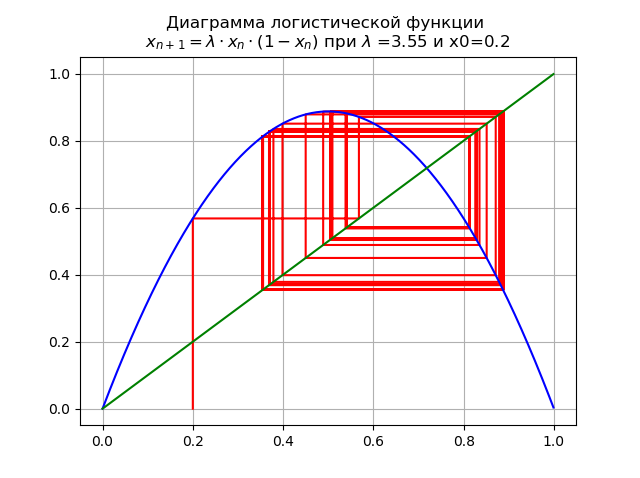
When the transition parameter lambda through value lambda=3.45 The 2-fold cycle becomes 4-fold, and beyond.
When the final value lambda=4 the system has unstable cycles of all possible orders:

To assess the impact of the nature of the logistics function on critical values lambda consider diagrams with a function xn+1=f(xn)= lambda cdotxn cdot(1−x2n) For this we will apply listing №2.
With 0< lambda<=1.0 for lambda=0.5 and x0 = 0.2:

The display has a single fixed point. x∗=0 which is sustainable.
With 1< lambda<=1.998... for lambda=1.8 and x0 = 0.55:
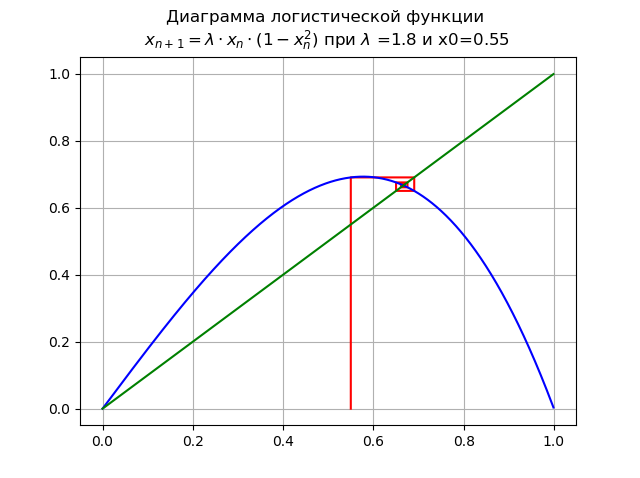
Point x∗=0 loses stability, a new stable point appears x∗1
With 1.99< lambda<=2,235... for lambda=2,2 and x0 = 0.2:
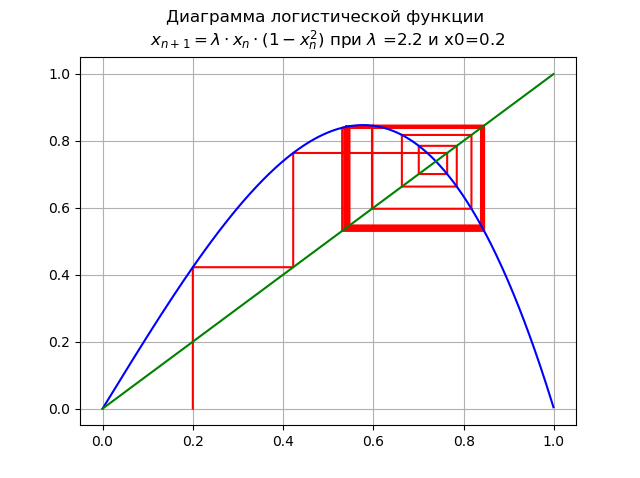
A period doubling bifurcation occurs, a 2-fold cycle appears. Further increase lambda leads to a cascade of period doubling bifurcations.
With 2,235< lambda2.5980... for lambda=$2.28 and x0 = 0.2:
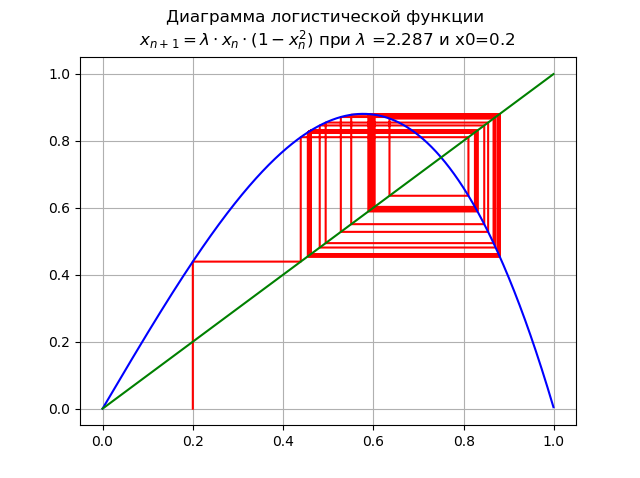
Increase lambda led to a cascade of period-doubling bifurcations.
With lambda=2.59 the system has unstable cycles of all possible periods:

As shown in the diagrams, with increasing order of the logistic function, the range of change lambda tapers off.
Using diagrams, we traced the path from order to chaos, while setting the values lambda for different logistic functions. It remains to answer the question: how to measure chaos? The answer for some of the types of chaos listed at the beginning of this article is known
- entropy measure of chaos. This answer can be fully attributed to informational chaos, however what is the entropy to apply here and how to compare with the already considered numerical value lambda - I will try to answer this question in the next part of the article.
Informational entropy and entropy coefficient
We will consider information binary entropy for independent random events. x c n possible states distributed with probabilities pi(i=1,..,n) . Information binary entropy is calculated by the formula:
H(x)=− sumni=1pi cdotlog2(pi)
This value is also called the average message entropy. Magnitude Hi=−log2(pi) is called private entropy, which characterizes only the i -e state. In the general case, the base of the logarithm in the definition of entropy can be any greater than 1; his choice determines the unit of measurement of entropy.
We will use decimal logarithms in which entropy and information are measured in bits. The amount of information in bits will be calculated correctly when, for example, variables X and Delta they will be substituted into the corresponding expressions for entropy no matter what, but necessarily in the same units. Really:
q=H(x)−H( Delta)=log10 left(X2−X1 right)−log10(2 Delta)=log10( fracX2−X12 Delta)
where X and Delta must be in the same units.
The estimate of the entropy value of a random variable from experimental data is found by a histogram of the following relationship:
Deltae= frac12eH(x)= fracd2 prodmi=1( fracnni) fracnin= fracdn210− frac1n summi=1nilog10(ni)
Where: d –The width of each column of the histogram; m - number of columns; n - total amount of data; ni - amount of data in i -that column.
The entropy coefficient is determined from the relationship:
ke= frac Deltae sigma
Where: sigma - standard deviation.
Informational entropy as a measure of chaos
To analyze the phenomena of informational chaos using the entropy coefficient, we first create a branch diagram for the function xn+1=f(xn)= lambdaxn(1−xn) with the application of transition regions obtained in the construction of histograms:
Branch Chart
import matplotlib.pyplot as plt import matplotlib.pyplot as plt from numpy import* N=1000 y=[] y.append(0.5) for r in arange(3.58,3.9,0.0001): for n in arange(1,N,1): y.append(round(r*y[n-1]*(1-y[n-1]),4)) y=y[N-250:N] x=[r ]*250 plt.plot( x,y, color='black', linestyle=' ', marker='.', markersize=1) plt.figure(1) plt.title(" 3,6<= $\lambda$ <=3,9") plt.xlabel("r") plt.ylabel("$\lambda$ ") plt.axvline(x=3.63,color='black',linestyle='--') plt.axvline(x=3.74,color='black',linestyle='--') plt.axvline(x=3.83,color='black',linestyle='--') plt.axvline(x=3.9,color='black',linestyle='--') plt.show() We get:
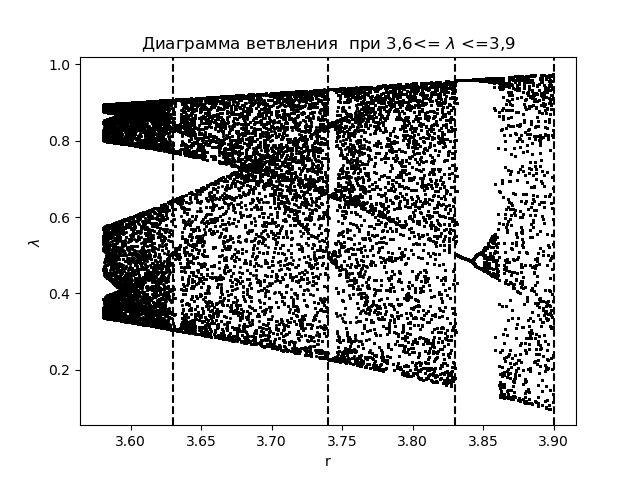
Construct a graph for the entropy coefficient for the same areas lambda :
Graph for entropy coefficient
import matplotlib.pyplot as plt from numpy import* data_k=[] m='auto' for p in arange(3.58,3.9,0.0001): q=[round(p,2)] M=zeros([1001,1]) for j in arange(0,1,1): M[0,j]=0.5 for j in arange(0,1,1): for i in arange(1,1001,1): M[i,j]=q[j]*M[i-1,j]*(1-M[i-1,j]) a=[] for i in arange(0,1001,1): a.append(M[i,0]) n=len(a) z=histogram(a, bins=m) if type(m) is str: m=len(z[0]) y=z[0] d=z[1][1]-z[1][0] h=0.5*d*n*10**(-sum([w*log10(w) for w in y if w!=0])/n) ke=round(h/std(a),3) data_k.append(ke) plt.title(" ke 3,6<= $\lambda$ <=3,9") plt.plot(arange(3.58,3.9,0.0001),data_k) plt.xlabel("$\lambda$ ") plt.ylabel("ke") plt.axvline(x=3.63,color='black',linestyle='--') plt.axvline(x=3.74,color='black',linestyle='--') plt.axvline(x=3.83,color='black',linestyle='--') plt.axvline(x=3.9,color='black',linestyle='--') plt.grid() plt.show() We get:

Comparing the diagram and the graph, we see an identical display of the regions in the diagram and in the graph for the entropy coefficient for the function xn+1=f(xn)= lambdaxn(1−xn) .
For further analysis of the phenomena of information chaos using the entropy coefficient, we will create a branch diagram for the logistic function: xn+1=f(xn)= lambda cdotxn cdot(1−x2n) with the application of transition areas:
Branch Chart
import matplotlib.pyplot as plt from numpy import* N=1000 y=[] y.append(0.5) for r in arange(2.25,2.56,0.0001): for n in arange(1,N,1): y.append(round(r*y[n-1]*(1-(y[n-1])**2),4)) y=y[N-250:N] x=[r ]*250 plt.plot( x,y, color='black', linestyle=' ', marker='.', markersize=1) plt.figure(1) plt.title(" 2.25<=$\lambda$ <=2.56") plt.xlabel("$\lambda$ ") plt.ylabel("y") plt.axvline(x=2.34,color='black',linestyle='--') plt.axvline(x=2.39,color='black',linestyle='--') plt.axvline(x=2.45,color='black',linestyle='--') plt.axvline(x=2.49,color='black',linestyle='--') plt.axvline(x=2.56,color='black',linestyle='--') plt.show() We get:
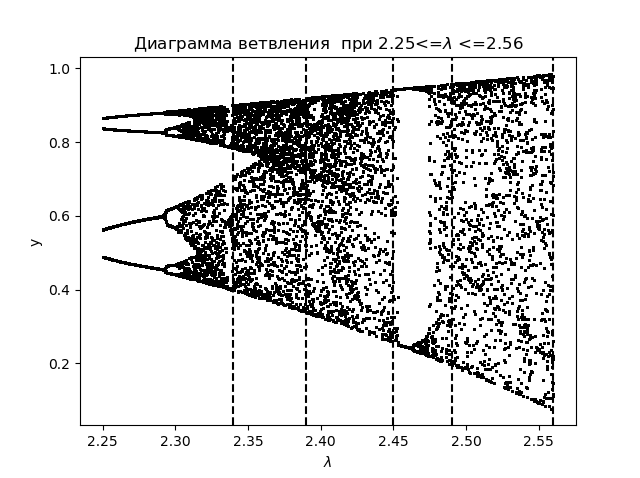
Construct a graph for the entropy coefficient for the same areas lambda :
Entropy Ratio Graph
import matplotlib.pyplot as plt from numpy import* data_k=[] m='auto' for p in arange(2.25,2.56,0.0001): q=[round(p,2)] M=zeros([1001,1]) for j in arange(0,1,1): M[0,j]=0.5 for j in arange(0,1,1): for i in arange(1,1001,1): M[i,j]=q[j]*M[i-1,j]*(1-(M[i-1,j])**2) a=[] for i in arange(0,1001,1): a.append(M[i,0]) n=len(a) z=histogram(a, bins=m) if type(m) is str: m=len(z[0]) y=z[0] d=z[1][1]-z[1][0] h=0.5*d*n*10**(-sum([w*log10(w) for w in y if w!=0])/n) ke=round(h/std(a),3) data_k.append(ke) plt.figure(2) plt.title(" ke 2.25<= $\lambda$ <=2.56") plt.plot(arange(2.25,2.56,0.0001),data_k) plt.xlabel("$\lambda$ ") plt.ylabel("ke") plt.axvline(x=2.34,color='black',linestyle='--') plt.axvline(x=2.39,color='black',linestyle='--') plt.axvline(x=2.45,color='black',linestyle='--') plt.axvline(x=2.49,color='black',linestyle='--') plt.axvline(x=2.56,color='black',linestyle='--') plt.grid() plt.show() We get:
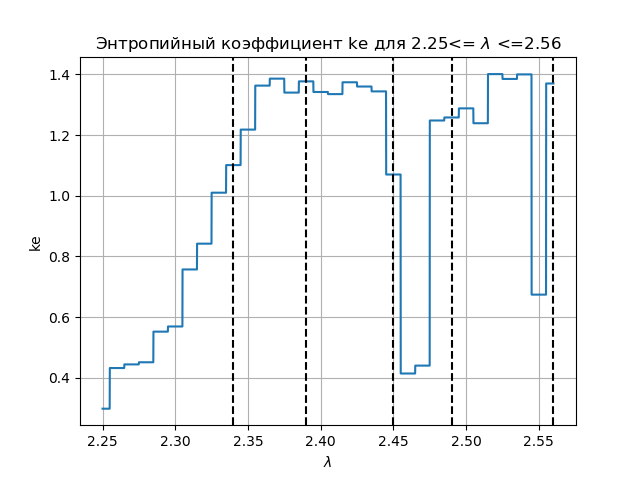
Comparing the diagram and the graph, we see an identical display of the regions in the diagram and in the graph for the entropy coefficient for the function xn+1=f(xn)= lambda cdotxn cdot(1−x2n)
Findings:
The article solved the educational problem: is the informational entropy a measure of chaos, and the means of Python are given an affirmative answer to this question.
Links
Source: https://habr.com/ru/post/447874/
All Articles